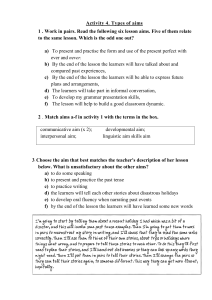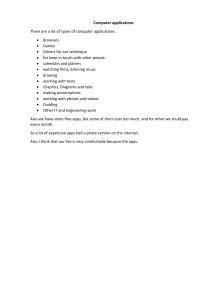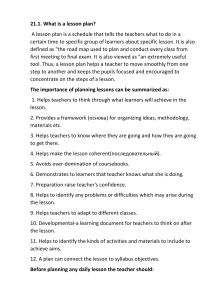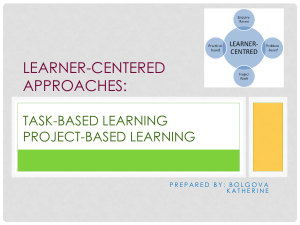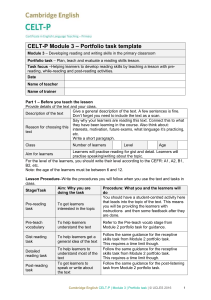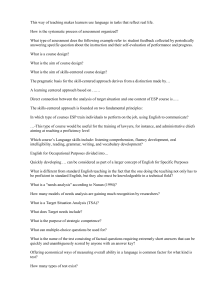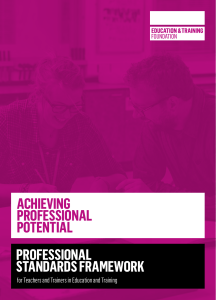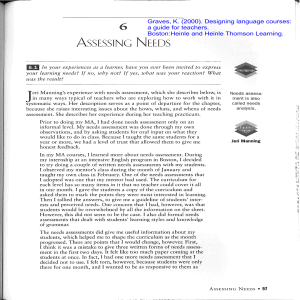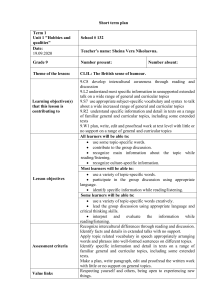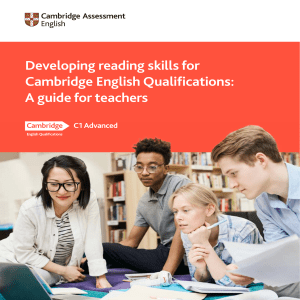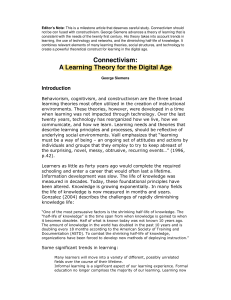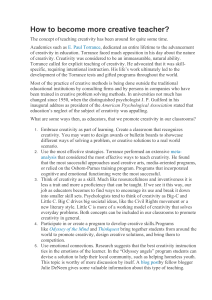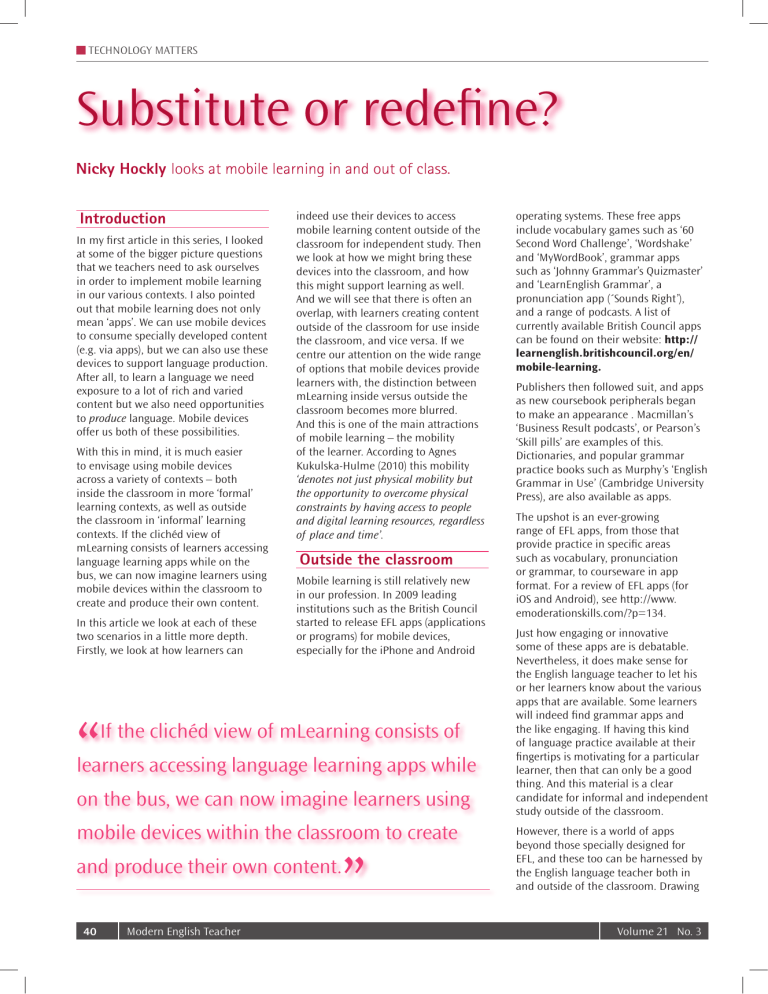
TECHNOLOGY MATTERS Substitute or redefine? Nicky Hockly looks at mobile learning in and out of class. Introduction In my first article in this series, I looked at some of the bigger picture questions that we teachers need to ask ourselves in order to implement mobile learning in our various contexts. I also pointed out that mobile learning does not only mean ‘apps’. We can use mobile devices to consume specially developed content (e.g. via apps), but we can also use these devices to support language production. After all, to learn a language we need exposure to a lot of rich and varied content but we also need opportunities to produce language. Mobile devices offer us both of these possibilities. With this in mind, it is much easier to envisage using mobile devices across a variety of contexts – both inside the classroom in more ‘formal’ learning contexts, as well as outside the classroom in ‘informal’ learning contexts. If the clichéd view of mLearning consists of learners accessing language learning apps while on the bus, we can now imagine learners using mobile devices within the classroom to create and produce their own content. In this article we look at each of these two scenarios in a little more depth. Firstly, we look at how learners can indeed use their devices to access mobile learning content outside of the classroom for independent study. Then we look at how we might bring these devices into the classroom, and how this might support learning as well. And we will see that there is often an overlap, with learners creating content outside of the classroom for use inside the classroom, and vice versa. If we centre our attention on the wide range of options that mobile devices provide learners with, the distinction between mLearning inside versus outside the classroom becomes more blurred. And this is one of the main attractions of mobile learning – the mobility of the learner. According to Agnes Kukulska-Hulme (2010) this mobility ‘denotes not just physical mobility but the opportunity to overcome physical constraints by having access to people and digital learning resources, regardless of place and time’. Outside the classroom Mobile learning is still relatively new in our profession. In 2009 leading institutions such as the British Council started to release EFL apps (applications or programs) for mobile devices, especially for the iPhone and Android “ If the clichéd view of mLearning consists of learners accessing language learning apps while on the bus, we can now imagine learners using mobile devices within the classroom to create ” and produce their own content. 40 Modern English Teacher operating systems. These free apps include vocabulary games such as ‘60 Second Word Challenge’, ‘Wordshake’ and ‘MyWordBook’, grammar apps such as ‘Johnny Grammar’s Quizmaster’ and ‘LearnEnglish Grammar’, a pronunciation app (´Sounds Right’), and a range of podcasts. A list of currently available British Council apps can be found on their website: http:// learnenglish.britishcouncil.org/en/ mobile-learning. Publishers then followed suit, and apps as new coursebook peripherals began to make an appearance . Macmillan’s ‘Business Result podcasts’, or Pearson’s ‘Skill pills’ are examples of this. Dictionaries, and popular grammar practice books such as Murphy’s ‘English Grammar in Use’ (Cambridge University Press), are also available as apps. The upshot is an ever-growing range of EFL apps, from those that provide practice in specific areas such as vocabulary, pronunciation or grammar, to courseware in app format. For a review of EFL apps (for iOS and Android), see http://www. emoderationskills.com/?p=134. Just how engaging or innovative some of these apps are is debatable. Nevertheless, it does make sense for the English language teacher to let his or her learners know about the various apps that are available. Some learners will indeed find grammar apps and the like engaging. If having this kind of language practice available at their fingertips is motivating for a particular learner, then that can only be a good thing. And this material is a clear candidate for informal and independent study outside of the classroom. However, there is a world of apps beyond those specially designed for EFL, and these too can be harnessed by the English language teacher both in and outside of the classroom. Drawing Volume 21 No. 3 TECHNOLOGY MATTERS or mind-mapping apps can be used by learners to produce summaries or schemas in or out of class. Photo apps can be used to photograph English words in the environment (e.g. in advertisements, signs, menus or movie posters) and learners can bring these to class as discussion prompts. Audio apps (or video recording) can be used to record independent pronunciation practice or for rehearsing presentations. Inside the classroom What about bringing elements of mobile learning into the classroom itself? There are a number of ways to start doing so, and below are five suggestions, starting from simple oneoff activities to more complex project work. Each of these suggestions works with mobile phones, from low-end phones to more sophisticated smart phones. Show and tell Start simple, start small and start without mobile devices at all. Let learners talk about their mobile phones, and what they use them for. Many of us develop deep emotional attachments to our phones, and love showing or telling others about them. See for example a lesson plan introducing the topic of mobile phones from Jo Budden on the British Council Teach English website: http://www.teachingenglish.org.uk/ language-assistant/essential-uk/mobilephones. An activity like this can be the first step in starting to use mobile devices regularly in class. SMS Reading an Internet-enabled mobile phone. Engage reluctant low-level readers by sending them simple, short, serialised stories via daily SMS messages. These short texts can be sent during class time, and then further activities devised around the content. If your phone is wifi enabled, use a free group messaging app such as gText (https://www.gtext.com) to avoid SMS costs. See Carol Rainbow’s account of how she carried out an SMS reading project with young learners: http:// carol-carolrb.blogspot.com.es/2011/04/ mlearning-history-sms-project.html. In this particular project a class set of low cost mobile phones was procured for the learners, and parental permission was sought to send the learners regular messages to develop their reading skills. Creating a treasure hunt Recording Get learners to audio and/or video record themselves in pairs while carrying out a speaking task in class. Let the learners use this to monitor and provide feedback on their own speaking performances. These recordings don’t need to be shown to anyone else if they are for rehearsal and analysis by the learners themselves. Learners can also record themselves giving more polished presentations, which then can be uploaded to a blog or website to be shared more widely. Posterous (https:// posterous.com/) is a free website that enables learners to quickly and easily upload audio or video files directly from Get learners creating treasure hunts for each other using location-based quiz apps on smart phones. Read about Anne Fox’s local history treasure hunt project for groups of young learners on mobile devices in Denmark (http://annefox. eu/2011/11/21/the-history-gamepart-2/). Anne had her learners work in small groups to take photos of key historical landmarks in her town, and to create multimedia quiz questions about these landmarks, for other groups. The quiz questions required images, sound, video and/or text answers. Quiz questions were activated by learners actually visiting the landmarks. Classroom time was spent on preparing the treasure hunt routes and questions. The quizzes were taken by the learners outside of the classroom – they needed to physically visit each landmark to be able to answer a question. You can download Anne’s lesson plan for this project here: http://www. theconsultants-e.com/resources/lessons/ lessonrepository/mlearningplans.aspx. Evaluating mobile activities There have been a number of mobile learning frameworks proposed, and perhaps the most useful for our purposes is the SAMR model by Ruben Puentedura (http://www.hippasus.com/ rrpweblog/archives/000049.html): Texting Carry out short focused classroom activities in which learners use the texting or note-taking features of their mobile phones. Here are a couple of examples: • Give learners a short dictation to take on their phones. • Send your learners a few SMS message in text speak (or put them on the board). In small groups learners type the same messages in standard English, and text these messages back to you. • In small groups get your learners to create short chain stories using a note-taking app. Volume 21 No. 3 www.onlineMET.com (Image from JISC Mobile Learning Infokit: 78) 41 TECHNOLOGY MATTERS The SAMR model is essentially a taxonomy of mobile task types that can help us identify just how innovative our use of mobile technology is for a specific task. If we only encourage our learners to use mobile apps such as dictionaries, flashcards or grammar activities, we are clearly restricting the use of mobile technologies to the ‘Substitution’ level. Flashcard apps replace paper flashcards, grammar apps replace print grammar practice books, and pronunciation apps replace audio CDs. Although the mobile technology may allow some bells and whistles to be added to traditional resources in these cases (such as flashcards in which you can check the pronunciation of words), we are essentially seeing the same content and approaches we have had for decades. This is fine, but we don’t want to lose sight of the other levels in the SAMR model – which we all too often do in our tendency to believe that mobile learning = apps. From Substitution to Augmentation Let’s look again at our five classroom examples above. We see that example 2 (Texting) is an example of ‘Substitution’ if learners take down a dictation from the teacher, with the text or note-taking feature of a mobile phone simply substituting pen and paper. However, if learners create a text chain story and then upload it to a Posterous blog for other classes (or parents) to access and comment on, then we see that the mobile technology has provided ‘functional improvement’ by allowing the learners’ work to be shared much more easily with a wider audience. The text chain story, then, is an example of an activity that uses the available technology for ‘Augmentation’, rather than simply ‘Substitution’. In both cases, we see that mobile technology enhances the activity – even if only by providing an alternative and original way of carrying out a standard dictation, which might increase student motivation. Modification Tasks which falls within Puentedura’s ‘Modifications’ section are our examples 3 (SMS Reading) and 4 (Recording). The SMS Reading activity requires us to 42 Modern English Teacher modify or create short texts which are delivered individually to learners via SMS, at regular intervals during a day, and over a period of several weeks. It’s difficult to envisage carrying out such a project effectively without mobile technology in this case. In our Recoding example, the mobile technology allows learners to make individual recordings (audio or video) of their language output quickly and easily, and to examine this immediately and privately in situ. They can delete and re-record as often as they like, until they are happy with the results, which then can be shared with a wider audience online. In the case of publicly sharing their recordings, the affordances of mobile technology allow learners to easily rehearse time and again, and class time can effectively be apportioned for this, with no loss in motivation for learners, and with the teacher providing feedback on performances until the final take is ready for sharing. Here we see a task being redesigned to include a substantial amount of time for output including rehearsal and repetition, something teachers are often reluctant to spend much class time on, but an important part of language learning. Thus in examples 3 and 4 we have moved from ‘enhancement’ of traditional tasks, to ‘transformation’ of tasks enabled by (mobile) technology. Redefinition And finally, our example 5 (Treasure hunt) is a good example of ‘Redefinition’. Here mobile technology enables learners to create and complete tasks previously unimaginable before the advent of GPS-enabled devices. The SAMR framework can provide a useful yardstick for teachers when starting to use mobile devices in the classroom. It can help us to gauge to what extent we are using all the affordances of mobile technology, or to what extent we are simply substituting one medium (e.g. pen and paper) for another (note-taking apps). Starting off with activities that focus more on substitution is a good way to start using mobile devices for teachers, but ideally one would want to include activities for all stages of the SAMR model over time. Although many of our learners have mobile devices, there are still many institutions that prohibit their use. And there are also still plenty of teachers who are not convinced that using mobile devices is worthwhile, or brings anything to the learning process. The obstacles and caveats to mobile learning will be examined in my next article in the series. REFERENCES Kukulska-Hulme, Agnes. (2010) Mobile learning as a catalyst for change In: Open Learning Vol. 25/3, pp.181-185 Puentedura, Ruben. (2010) Accessed at: http://www.hippasus.com/rrpweblog/ archives/000049.html JISC Mobile Learning Infokit. (2012) Accessed at: https:// mobilelearninginfokit.pbworks.com/w/ page/41122430/Home Nicky Hockly Nicky Hockly has been involved in EFL teaching and teacher training since 1987. She is Director of Pedagogy of The Consultants-E, an online teacher training and development consultancy (www.theconsultants-e. com). She is co-author of How to Teach English with Technology, Learning English as a Foreign Language for Dummies, and Teaching Online. She is currently working on a new book Digital Literacies (forthcoming 2012), and recently produced her first e-book: Webinars: A Cookbook for Educators (http://the-round. com). Nicky maintains a blog at www.emoderationskills.com, and The Consultants-E regularly run an online teacher training course on mobile learning: “mLearning in Practice”. Volume 21 No. 3
